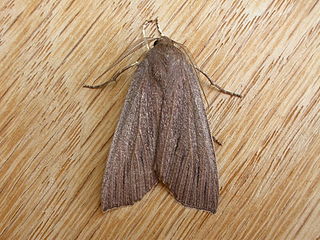Lambula is a genus of moths in the family Erebidae. The genus was erected by Francis Walker in 1866.

Palleopa is a monotypic moth genus in the family Geometridae. Its only species, Palleopa innotata, the finely-streaked crest-moth, is known from Australia, including Tasmania. Both the genus and species were first described by Francis Walker in 1866.

Musotima nitidalis is a species of moth of the family Crambidae described by Francis Walker in 1866. It is native to Australia and New Zealand and was first found in Europe in 2009.

Hypena conscitalis is a moth of the family Erebidae first described by Francis Walker in 1866. It is found throughout Africa, from Senegal to South Africa, in South and South-East Asia as well as in Australia and on some Pacific and Indian Ocean islands.
Lambula fuliginosa is a moth of the family Erebidae. It was described by Francis Walker in 1862. It is found on Borneo. The habitat consists of montane forests, dipterocarp forests and lowland forests.
Lambula melaleuca is a moth of the family Erebidae. It was described by Francis Walker in 1866. It is found on the Moluccas. It is the type species of the genus Lambula.

Elophila responsalis is a moth in the family Crambidae. It was described by Francis Walker in 1866. It is found in Australia, where it has been recorded from Queensland.
Strepsicrates semicanella is a species of moth of the family Tortricidae first described by Francis Walker in 1866. It is found in south-east Asia and in New Caledonia, Australia and Japan. The habitat consists of alluvial forests.
Culladia hastiferalis is a moth in the family Crambidae. It was described by Francis Walker in 1866. It is found on Borneo, Sumatra, Java, Sulawesi, the Moluccas, New Guinea, Taiwan, the Philippines (Luzon) and Australia, where it has been recorded from Northern Territory and Queensland.
Agrioglypta excelsalis is a moth in the family Crambidae described by Francis Walker in 1866. It is found on Sulawesi, Lifou Island, as well as in Bhutan, Thailand and Australia, where it has been Western Australia, Queensland and northern New South Wales.

Chalcidoptera emissalis is a moth in the family Crambidae. It was described by Francis Walker in 1866. It is found in north-eastern India, Sri Lanka, Burma, Singapore, Borneo, Ambon Island, Aru, New Guinea and Australia, where it has been recorded from Queensland.
Conogethes semifascialis is a moth in the family Crambidae. It was described by Francis Walker in 1866. It is found in India and Australia, where it has been recorded from New South Wales and Queensland.
Cydalima diaphanalis is a moth in the family Crambidae. It was described by Francis Walker in 1866. It is found in Burma, Indonesia, on the Solomon Islands and in Thailand and Australia, where it has been recorded from Queensland and South Australia.
Nausinoe globulipedalis is a moth in the family Crambidae. It was described by Francis Walker in 1866. It is found in Indonesia (Sulawesi), New Guinea and Australia, where it has been recorded from Queensland.
Nosophora hypsalis is a moth in the family Crambidae. It was described by Francis Walker in 1866. It is found in the Aru Islands of Indonesia and Australia, where it has been recorded from Queensland.
Omiodes dispilotalis is a moth in the family Crambidae. It was described by Francis Walker in 1866. It is found in Indonesia and Australia, where it has been recorded from Queensland.
Omiodes surrectalis is a moth in the family Crambidae. Described by Francis Walker in 1866, it is found in the Democratic Republic of the Congo, India, Indonesia, the Philippines, Sri Lanka, New Guinea and Queensland, Australia.
Pygospila bivittalis is a moth in the family Crambidae. It was described by Francis Walker in 1866. It is found in India, China, Indonesia, New Guinea and Australia, where it has been recorded from Queensland.
Tatobotys biannulalis is a moth in the family Crambidae. It was described by Francis Walker in 1866. It is found on Borneo and in Indonesia, the New Hebrides, Fiji, Samoa, Japan, Sri Lanka and Australia, where it has been recorded from the Northern Territory and Queensland.
Cryptophasa balteata is a moth in the family Xyloryctidae. It was described by Francis Walker in 1866. It is found in Australia, where it has been recorded from New South Wales, Queensland and South Australia.




